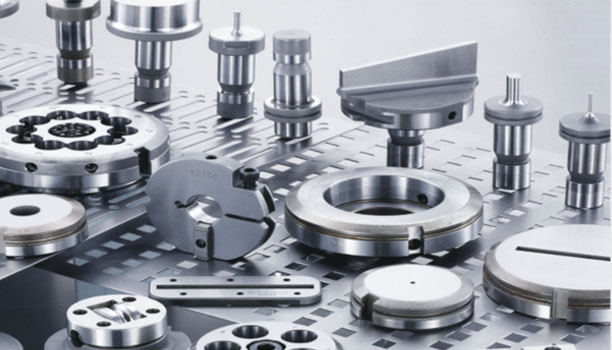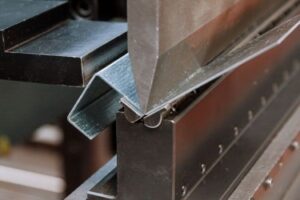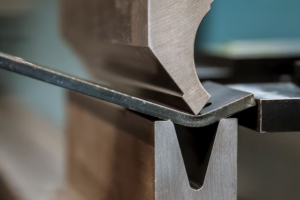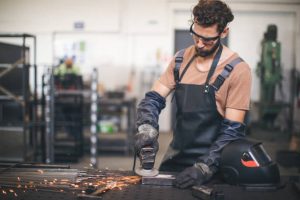Punching is one of the important sheet metal-forming and fabrication processes. When forming sheet metal, sheets are often perforated to create holes for many purposes. Traditionally, shear punching or drilling is used to make holes in metal sheets.
However, many factors need to be considered in order to create an effective and error free hole. Factors such as sheet dimensions, force applied, method of hole making, equipment used for punching or drilling, etc. are factors that often affect the effectiveness of punching or drilling sheet metal. This post provides guidelines for punching in sheet metal.
The following considerations can assist in punching and drilling the correct holes in sheet metal.
Preparations: The process of punching begins with the preparation of the sheet. These preparations may include measuring sheet dimensions, surface preparation, center marking, etc. Preparation can be done in the following order.
Surface Preparation: This may include degresing and clean the sheet metal. Removing dirt, dust, grease and burrs from sheets can help prepare it for the forming process.
Dimension Measurement: Measuring the dimensions of a sheet may involve measuring the thickness, width, and length of the sheet. The choice of hole-making processes is influenced by thickness, whereas clamping is influenced by length and width.
Clamp the Sheet Metal: Clamp the sheet firmly. The edges of the sheets should be clamped for punching or drilling on the forming operation. After clamping the edges of the sheet, check the sheet for movement. There should be no twisting, slipping, etc. between the sheet and the clamp. Masking the back of the sheet with tape can assist avoid damage and tearing from clamping pressures.
Choose Suitable Tools: The tools for making holes should be selected based on the thickness of the sheets and the hole-pattern.
Punch Press: Punch press can be used to cut holes in sheet metal. This method allows multiple holes to be cut in a circle. In this way the time and effort involved in punching in sheet metal can be reduced.
Finish Edges: The edges of holes are susceptible to bending and sharpening during drilling or punching. To prevent cuts, it is important to machine the edges and blunt them. To soften the edge, sandpaper polishing, edge grinding, and other methods may be required.
Salvagnini Tooling
Salvagnini’s high-performance punching system is enhanced with high-speed steel punches, dies, and strippers like no other. Salvagnini’s whole metal fabricating system is enhanced by complete variety of standards, unique forms, and forming assemblies available to customer specifications.
The features of the punching machine:
- High rigidity.
- Stable high precision.
- Safe and Reliable operation.
- Labor-saving, Automated production, High efficiency.
- Slider adjustment mechanism.
- Environmental protection, Novel design
Thick Turret Punching Tools
Thick turret tooling systems in the industry: innovative QCT™ high performance UltraTEC®, quick change tooling, convenient Ultra XT™ and economical core style.
Trumpf Style Tooling
In order to provide full functionality, this web site requires your explicit consent to store browser cookies.
If you do not allow cookies, you may not be able to use certain features of the web site, including but not limited to: log in, purchase products, view personalized content, site cultures switch between.
Your TRUMPF punch press may now be equipped with smarter, more productive equipment that provides you more.
Extended grind life with a GL die specially designed for TRUMPF machines. 2-4-1 punches made of quality steel provide more uptime. More durability with a lightweight aluminum cartridge and much more.
As a manufacturer, you know that great progress in production comes only when you work hard against the good and move forward for the better.
That’s why you shouldn’t settle for a tooling provider that relies on the status quo. When you choose a tooling for your TRUMPF machine, make sure it is from a brand that not only makes the tooling, but improves it.
Punch Presses
A punch press consists of two covalent components: the punch, which is attached to the machine’s reciprocating ram, and the die, which is mounted on a bed or anvil who’s the flat surface is parallel to the ram’s path.
In operation, the punch pushes against the workpiece, which is in the die. A blanking die converts a slug of sheet metal into a blank that is then dies for punch-press operations.
These include forming or bending and stretching, in which cup-shaped articles are produced by a process that forces some plastic flow of metal.
Punch presses are typically driven by electric motors, and the ram’s reciprocal conversion from the rotary motion of the drive shaft is affected by a crank, toggle, or cam mechanism. Because the power demand is intermittent, a flywheel is attached to the drive shaft to store energy during the idle period between the strokes of the ram and to provide energy to the shaft during a punching operation, thus to reduce the required capacity of type driving motor.
CNC Turret Punch Press
NCT Punch Press is one of the primary types of CNC Punching Machine, also known as CNC Punching Machine.
NCT is a pressure processing machine that uses turret punching tooling to do deep punching and shallow drawing on plate. Mechanical, electrical, hydraulic, and pneumatic components are all integrated.
The CNC Turret Punching Machine is a versatile automatic machine that can adapt to frequent product changes.
The machining process necessitates a number of operations and steps and the relative displacement between the tool and the workpiece to send digital information into the operation of special or general computers, computer processing and input information, to issue various instructions to control the machine’s servos, represented by digital codes through control media (such as paper tape or discs) system or other working component so that the machine can automatically process the required parts or products.
Punching Dies
Tungsten carbide or Hardened steel are commonly used for punch tooling (punch and die). A die is positioned on the opposite side of the workpiece and helps to localise shear forces for a cleaner edge by supporting the material around the perimeter of the hole.




